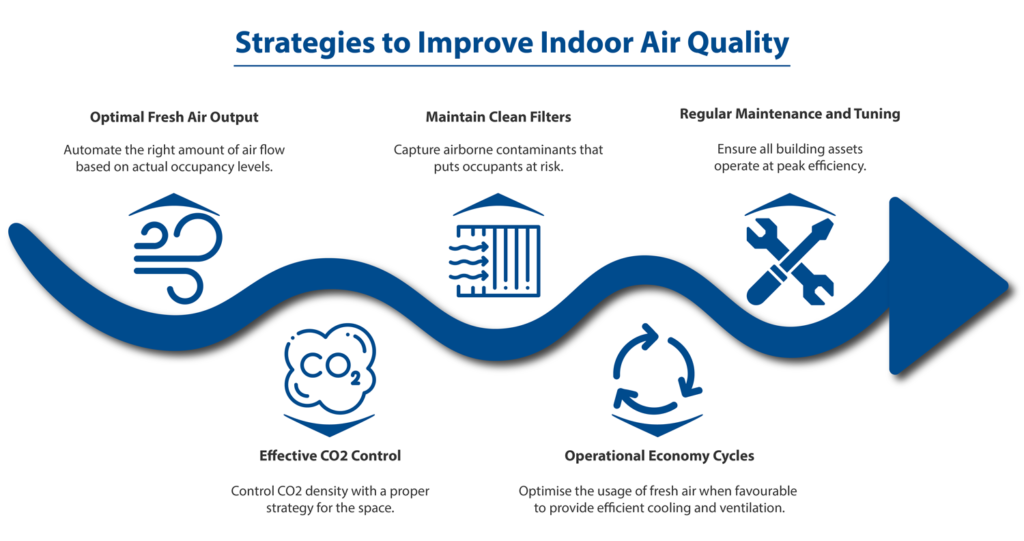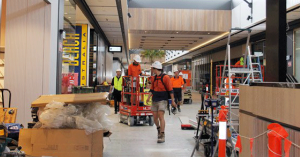Air quality means more than just meeting tenant expectations for indoor comfort – it requires anticipating tenant well-being to ensure a healthy, productive & comfortable environment.
There are numerous variables that determine indoor air quality, commonly including temperature, CO2 levels and humidity. Each of these variables plays a different role in determining the quality of air that is inhaled but together they influence the overall comfort of the space. The variations in air quality can be caused by numerous factors which include overcrowding, presence of pollutants in the indoor environment as well as ventilation effectiveness within the space.
Ensuring good indoor air quality is extremely important as it provides a wide range of benefits for the tenants who utilise the space to provide a healthy and comfortable environment, it also optimises building performance and reduces unnecessary energy use.
Importance of Indoor Air Quality in a Commercial Office Space
Commercial office spaces generally have a dense population, minimal natural ventilation and lots of closed spaces. With more people comes more CO2, and naturally, heat is produced which can drastically affect the quality of air in space. Therefore, building owners need to ensure that there is adequate fresh air, backed by enough heating and cooling units to help control the quality of air and keep it at a high standard for all tenants. Employees are the most valuable asset of any company, and overall performance and efficiency is heavily affected by air quality and comfort levels.
A crucial problem that building owners need to solve is deciding how much fresh air needs to be added into the building to ensure optimal indoor air quality is maintained. Pulling fresh air into a building is extremely costly as it requires a large amount of energy to condition this air before distributing it throughout the building. This problem needs to be solved if building owners wish to ensure a high level of air quality while still maintaining reasonable operating costs. Here’s a closer look at 5 effective strategies to improve air quality:

Strategy 1: Using Occupancy to Determine the Optimal Amount of Fresh Air Flow
In accordance with Australia Standard 1668.2, there is a minimum requirement of 10 l/s per person of fresh air that needs to be ventilated through a building during occupied times. In most buildings, the minimum outside air quantity is fixed based on the number of floors being occupied. Being able to measure the number of people on the floor and quantity of outside air intake, businesses can ensure better thermal comfort and reduce overall energy consumption and compliance to the Australian standard.
Strategy 2: Effective CO2 Control
The density of CO2 within the indoor environment is one of the key determinants of indoor air quality. It is a proxy that the Australian Standard uses to determine the number of people in the building as CO2 concentrations rise when the number of occupants increases. An accurate measure of CO2 is crucial but can be extremely challenging as in typical open floor plans, arrangement concentration of people is not uniform, meaning that typical single point detection in return air streams may not always provide an indicative reading. By creating a detailed assessment of seating businesses can design the best CO2 strategy for the space.
Strategy 3: Maintain Clean Filters
Maintaining clean filters is extremely important as they capture airborne contaminants and over time, the build-up of these contaminants can lead to a risk hazard that puts the occupants at risk. This contaminant build-up can encourage legionella in humid climates. Depending on the location, the orientation of the building and the impact of latent conditions such as salt water and dust levels, the replacement of these filters may vary.
One of the easiest ways to determine the need for a replacement is by measuring the filter differential pressure drop. The task may appear to be relatively simple, but it is more complex than what most people anticipate it to be. For a fixed speed system, the problem can be fixed relatively simply, by assigning a fixed pressure setpoint alarm the relevant parties will be notified once the pressure drop increases.
The situation is much more complicated for the variable air volume system, where fans operate at a variable speed in response to the field demand. Therefore, the previously mentioned solution won’t work as maximum flow conditions are only experienced a few days a year during extreme weather conditions. To resolve this issue, it is suggested to implement a variable threshold that is linearly correlated to the fan speed or duct static pressure. Businesses can design such strategies to ensure that blockage of the filter and the need for a replacement is detected correctly.
Strategy 4: Operational Economy cycles
Economy cycle term relates to the operating air conditioning services using outside air when conditions are favourable. However, determining favourable conditions is not a simple task as multiple variables have to be taken into consideration to ensure that the benefits of fresh air do not compromise plant capacity and thermal condition.
In order to execute an efficient economy cycle, the building’s HVAC systems control and ensure the correct operation of the dampers and or supplementary fans to direct increased quantities of fresh air to the spaces it serves. Modulating actuators and variable speed drives can provide more efficient and less disruptive operations for the economic cycle, ensuring that its benefits are sustained for a prolonged period of time. Businesses can also design strategies to fully utilise the external environment by maximising the usage of fresh air when favourable to provide efficient cooling and ventilation.
Strategy 5: Regular Maintenance & Tuning
As it is a crucial part of the post-installation process, regular maintenance and tuning allow for all assets of the building to be operating at peak efficiency and as intended. This includes maintaining all HVAC systems so that to ensure that peak internal environment is achieved at all times without any inefficiencies present in the system.
The tuning process helps dial in the system which will minimise overcooling and overheating to achieve the most comfortable conditions for the end-user while reducing energy consumption.
Alerton Australia’s Improvement Strategies for Air Quality
As one of the leading HVAC specialists in the industry, Alerton Australia is here to help you improve your indoor air quality. Our systems ensure your building has the optimal amount of fresh air while implementing effective CO2 control to provide your tenants with the perfect indoor working environment. Through efficient filter cleaning and proper utilisation of the external environment, our solutions ensure that clean fresh air is efficiently introduced into the internal environment.
Alerton Australia offers a preventative maintenance agreement for ongoing building fine-tuning optimisation under which we guarantee results such as improved asset performance and valuation, system performance and energy efficiency while providing no financial risk to the owner.
Contact our team today about improving your indoor air quality for your building or spaces with key optimisation strategies.




